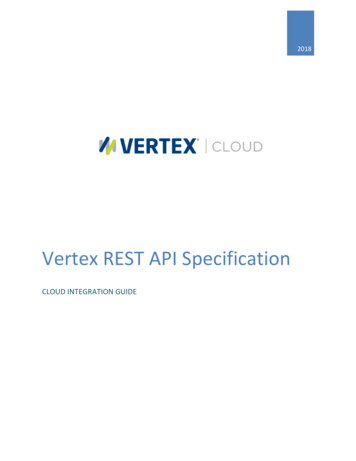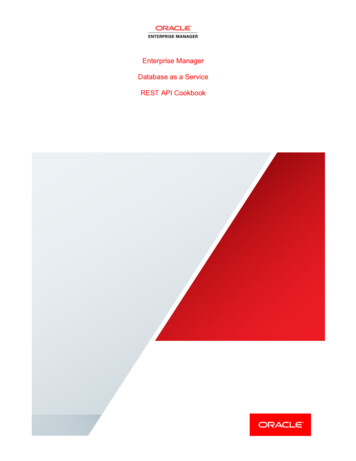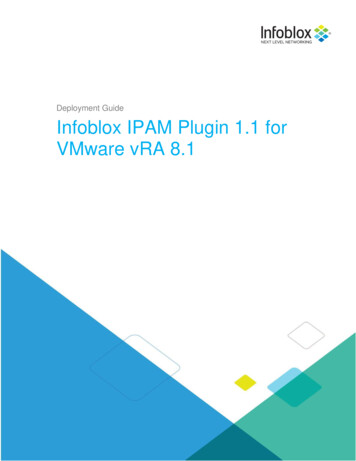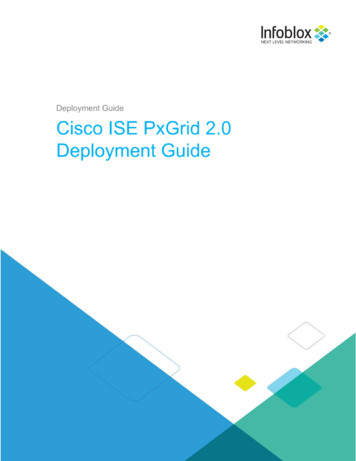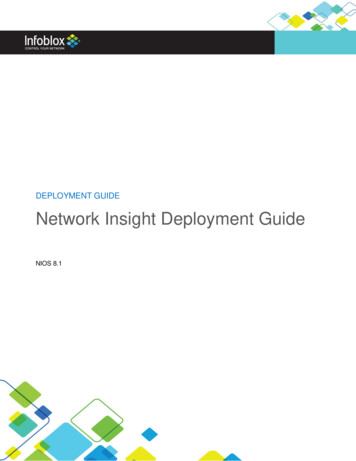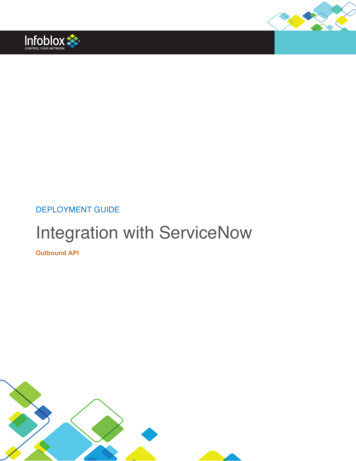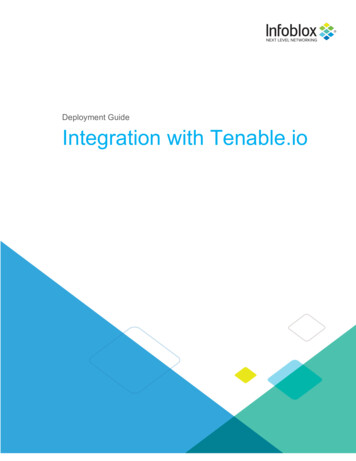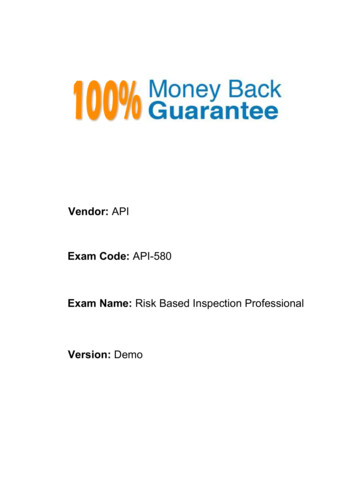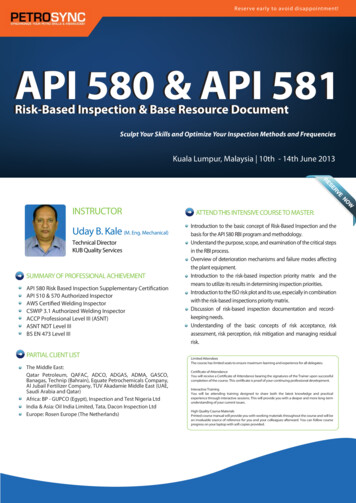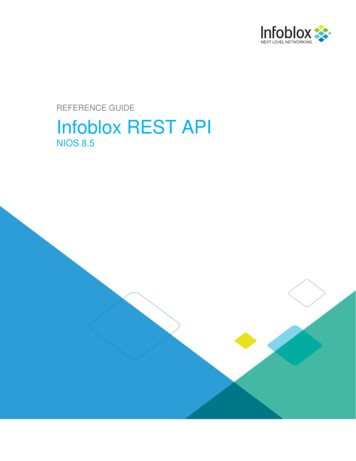
Transcription
REFERENCE GUIDEInfoblox REST APINIOS 8.5
Table of ContentsIntroduction5General Syntax and Options5Object Reference6Documentation6Common scenarios7Points to remember7Access9Authentication9Schema10Extensible Attributes11Extensible Attributes InheritanceDNS-related scenarios1213Zones13The most common record types15Retrieve all the records in a zone23Retrieve non-system generated records24Search for a record based on some criteria25Search for network objects based on regular expressions27Aliases for a host27Change the IP address of a host29Add or remove IP addresses from a host29Add a host with the next available IP address from a network30Add a host with a fixed address32Add Extensible Attributes to an object32TTL33Name Server Groups34Zone transfers34DNSSEC35Response Policy Zones38DNS Traffic Control44IP address management related scenarios46Add a network or container46Search for a network47Get next available subnet48
Get next available address from a subnet49Get all the addresses based on a search criteria49Zone associations on a network51Add a fixed address51Search for a fixed address by MAC52Complex search for a fixed address by Microsoft Server52Get information about an IP address53Get unused IP addresses in a subnet53Search for any object with an IP address54Search for an IP address54Delete an IP address54Network Views55VLAN Management57DHCP related scenarios59DHCP ranges59Search for a DHCP range by Extensible Attributes60DHCP Leases60Grid management related scenarios61Grid DNS ions68Export a CSV file69Export results of a WAPI call70Import a file (Certificate)70Import a CSV file71Grid database backup and restore72Grid upgrade73Traffic Capture74Sample paging request75Multiple Object Body Feature using /request78Get records of multiple record types78Delete a host record79Get next available IP address80Pre-provision a Grid member81Enable DHCP service on a member81
Get permissions for an object82Add multiple subnets82Add multiple host record83Sample Codes83Python83Powershell84Java86Using Java Unirest86Using Java OkHttpClient86C# (CSharp)References8787
IntroductionThe Infoblox WAPI is an interface based on REST (REpresentational State Transfer), also called aRESTful web API. These are not dependent on any programming language.It uses HTTP methods for operations and supports input and output in JSON and XML. It supports theprimary or most-commonly-used HTTP verbs: POST, GET, PUT, and DELETE. These correspond tocreate, read, update, and delete (or CRUD) operations, respectively.All API calls are encrypted using SSL/TLS and authenticated using HTTP basic authentication.General Syntax and OptionsAll WAPI requests consist of three parts; URL, Arguments and Data (body).URLThe first part of the URL consists of the host IP address (or FQDN) to which all the calls will be directed. Thesecond part of the URL identifies the requests as a WAPI request and specifies the expected version of WAPI.The URL syntax is grid IP wapi/v major.minor , e.g. x.x.x.x/wapi/v2.4/. The current version of the API is2.11.If you need to use a patch release, you can specify it as vx.x.x (like v2.6.1)The Infoblox WAPI has a versioning scheme that is independent of the NIOS versioning scheme. A currentWAPI version is backward compatible with WAPI releases that have the same major WAPI version or withdesignated earlier major versions.The last part of the URL identifies the resource, such as a network, on which the request operates.ArgumentsQuery arguments (after ‘?’) can be used to specify general options and method specific options and data forthe request. All options start with the character (underscore).The general options are schema, return type, return fields and method.With version 2.11, inheritance is introduced. If this option is set to True, fields which support inheritance, willdisplay data properly.Data (Body)Contains data that is dependent on the method. Only, PUT, and POST methods can have a Body on input. Allmethods have Body on output.ExampleGET https://172.26.1.2/wapi/v2.6/networkview? return type xml-pretty&name defaultGrid Master IP address VersionResourceArguments
Object ReferenceEvery WAPI Object is referenced by a unique Object Reference. WAPI returns this reference when an object iscreated, modified, deleted or read. This reference is used to identify the object for the same operations.An object reference is a string with the following format, without spaces:wapitype / refdata [ : name1 [ { / nameN }. ] ltwapityperefdatanameDocumentationFor more information, you can navigate to the WAPI documentation available at https:// grid IP /wapidoc
You can also find more information in the Support Site under NIOS in the Tech Docs section.Common scenariosThis section will cover the most common scenarios that you may encounter in your day-to-day activities whileworking with the Infoblox grid.Please note that this document will cover the most common use cases. It will not cover all the APIs available.For any additional information, please refer to the WAPI documentation.Points to remember For each of the use cases, this document will cover the API call and corresponding cURL commands.The Sample Codes section contains sample Python, Powershell, Java and C# code.In the following WAPI Samples, the guide uses a base url referenced as wapi url .Replace it with https:// grid master ip /wapi/ wapi version orhttps:// grid master fqdn /wapi/wapi version. Example: https://x.x.x.x/wapi/v2.11 orhttps://this.is.a.test.com/wapi/wapi versionTo get the latest version of WAPI supported by the Grid in your environment, refer to the Schemasection.In the sample cURL commands, replace the text in red with values specific to your environment.
By default, all the fields are not returned during a GET request. You can use the return fieldsargument to get the desired data. You would have to explicitly mention the additional fields yourequire with a return fields requiredfield You can set return as object argument to 1. This will change the format of the JSON output to makeit easy to parse by 3rd party libraries. It is recommended to set this as it standardizes the JSONformat and is less error prone.Set the max results option to 1 when you need to stop a search on the first match. This results in ahuge performance and speed improvement in large environments.When a search result yields a large number of results, you can use paging.o To start a paging request, the initial search request must have paging andreturn as object set to 1, and max results set to the desired page size.o The returned results object will contain the next page id field and the result field set to thefirst page of results. Note that the next page id field only contains URL-safe characters so itcan be used as is and no quotation characters are required for subsequent requests.o To get the subsequent results, you can re-send GET requests to the original object and setpage id to the ID string returned in the previous page of results.o For a sample request, refer to Sample paging requestWhen making POST, or PUT requests, it is easier to send the data as 'application/json' in the body ofthe message, since it lets you send complex data structures in the payload.Field and argument values must be quoted according to where they are used.Examples:o URL args, x-www-form-urlencoded:Use %xx encoding for “%”, ”;”, “/”, ”?”, ”:”, “@”, “&”, “ ”, “ ”, “ ”, ”,” and ” ” (a space)o JSON Data:Use JSON quoting, as specified at http://json.orgo XML Data:Use XML quoting (& etc.) as needed for XML.In the following examples, ‘ ’ is encoded as %2B, ‘:’ as %3A, ‘ ’ as 3C, ‘ ’ as 3EThe following examples include a sample output for each API call. This data is only representative ofthe test environment. “ .” indicates that there are more records returned than mentioned.By default, the output of POST, PUT, and DELETE contains the ref of the concerned object.PUT and DELETE operations require ref of the object you are working with.o In the following WAPI Samples, the text highlighted in green indicates an object referencespecific to the test environment. Please replace it with the object reference specific to yourenvironment. Example: In{wapi mZvLmhvc3Qx:host.info.com/defaultreplace with {wapi url}/ ref o You can get the ref by performing a GET operation.If a field is of type BOOLEAN, do not quote the word. Example: “is default”:trueSome fields are associated with a corresponding boolean flag value that has the prefix use . Forexample, ttl is associated with the flag use ttl. In an object, the value of this field will only take effectwhen its use flag is true. Otherwise, the value will be inherited from a higher-level setting. With WAPI2.11, you can get the inherited data by setting the inheritance argument to true.While searching for network objects, you can filter the data using regular expressions. You wouldneed to specify the modifier to indicate you are querying with a regular expression.o A search argument can use the following modifiersModifier!: ExplanationNegates the conditionMakes string matching case insensitiveRegular expression search. Expressions are unanchoredLess than or equalGreater than or equal
o Only one of the following can be specified at a time: greater than, less than, and regularexpressions.o Depending on the attribute type, following are modifiers supported by extensible attributes: integer and date support !, and . All other types behave like strings and support !, and :.When you need to update or create multiple records, you can store the data as fields in a CSV file andimport it at once. This will be faster in comparison with updating or creating each object with aseparate API call. The Import a CSV file section covers an example.The request object allows the control of WAPI through a single-entry point. The Multiple ObjectFeature enables to make multiple requests with one API call, thus simplifying an operation, andreducing the number of API calls to be made. You can find a few samples in the Multiple Object BodyFeature using /request section.AccessWAPI uses HTTPS (HTTP over SSL/TLS) as the transport mechanism. You can access WAPIs using variousmethods.1.2.3.Applications that allow you to make REST calls, like Insomnia and POSTMANAny programming language or utility, like curl and python (by importing the requests module)Any third-party application, that you want to integrate with, that supports REST methods, likeServiceNow and HP Operations Orchestrator.AuthenticationThe server certificate used for WAPI is the same certificate used by NIOS for the GUI.WAPI supports only HTTP Basic Authentication. You can use the connection for issuing multiple requests. Inthe case of multiple requests, authentication is handled by supplying the cookie (ibapauth) that was returnedafter the initial authentication. The IBAPAUTH cookie is sent back by the server to avoid repeat authenticationrequests. It is sent as an HTTPONLY, SECURE cookie.Example: set-cookie: ibapauth "ip 127.0.0.1,client API,group admingroup,ctime 1446631868,timeout 600,mtime 1446631868,su 1,auth LOCAL,user admin,NlxMltsoxDNvBWKrfOMy uxUMWS3guCB4yU"This cookie can be invalidated by sending a POST request to /wapi/v2.11/logoutWAPI supports the same underlying authentication methods that NIOS supports for username and password.This also applies to the cookie timeout which is the same value as the Grid UI timeout. All WAPI users musthave permissions that grant them access to the API.You can login with any API call. This will set the cookie.OperationA sample API call (Gethost records) to save thecookie generated to a filecalled cookies.txtRESTMethodAPI CallSample BodySample cURL CommandSample Outputcurl -k -u admin:infoblox -c cookies.txt -X GET "https://grid-master/wapi/v2.11/record:host? return as object 1"{"result":[{" ref": mhvc3Qx:host1.test.com/default","ipv4addrs":[{ " ref":"record:host nRlc3QuaG9zdDEuMTcyLjI2LjEu
A sample API call (Getzones) to show how touse the generated cookiefrom cookies.txtModify the sessiontimeoutInvalidate a "configure for dhcp": false,"host": "host1.test.com","ipv4addr": "172.26.1.200"}],"name": "host1.test.com","view": "default"}, .{" ref": {" ref":"record:host rinter.info.com/default","configure for dhcp": false,"host": "printer.info.com","ipv4addr": "160.20.1.100"}],"name": "printer.info.com","view": "default"}]}curl -k -b cookies.txt -X GET "https://grid-master/wapi/v2.11/zone auth? return as object 1"{"result":[{" ref": "zone /default","fqdn": "test.com","view": "default"}]}{"security setting":PUT wapi url /grid/b25lLmNsdXN0ZXIkMA:Infoblox{"session timeout": 60000}}curl -k -b cookies.txt -H 'content-type: application/json' -X PUT IkMA:Infoblox? return as object 1& return fields%2B security setting" -d '{"security setting":{"session timeout": 60000}}'{"result":{" ref": "grid/b25lLmNsdXN0ZXIkMA:Infoblox","security setting":{ "admin access items": [],"audit log rolling enable": true,"http redirect enable": false,"lcd input enable": true,"login banner enable": true,"login banner text": "Disconnect NOW if you have not been expressly authorized to use this system.","remote console access enable": false,"security access enable": false,"security access remote console enable": true,"session timeout": 600000,"ssh perm enable": true,"support access enable": false,"support access info": "Not enabled"}}}POST wapi url /logoutcurl -k -b cookies.txt -H 'content-type: application/json' -X POST "https://grid-master/wapi/v2.11/logout"SchemaThe schema argument returns the WAPI schema.If a WAPI schema is requested without specifying the type of network object, an object with information aboutrequested version of the WAPI schema, list of supported objects in the requested version, and list of allsupported versions will be returned.If you specify a network object while requesting WAPI schema, along with the above-mentioned information,you will get a list of cloud restrictions, list of fields of the object, list of object restrictions, requested object type,and actual requested version of the WAPI object schema.
RESTMethodOperationAPI CallSample cURL CommandSample OutputGet the overall WAPI Schema (supported versions andsupported objects)Get schema of an object (record:host can be replaced withany other object)GET wapi url /? schemacurl -k -u admin:infoblox -X GET "https://gridmaster/wapi/v2.11/? schema& return as object 1"{"result":{"requested version": "2.11","supported objects":["ad auth service","admingroup","adminrole", ."zone delegated","zone forward","zone rp","zone stub"],"supported versions":["1.0","1.1","1.2","1.2.1", "1.3","1.4","1.4.1", ."2.6","2.6.1","2.7", "]}}GET wapi url /record:host? schemacurl -k -u admin:infoblox -X GET "https://gridmaster/wapi/v2.11/record:host? schema& return as object 1"{"result":{"cloud additional restrictions":["function call"],"fields":[{"is array": true,"name": "aliases","standard field": false,"supports": "rwu","type": ["string"]},{"is array": false,"name": "allow telnet","standard field": false,"supports": "rwu","type": ["bool"]}, {"is array": false,"name": "zone","searchable by": " ","standard field": false,"supports": "rs","type": ["string"]}],"restrictions": [],"type": "record:host","version": "2.11"}}Extensible AttributesOperationGet the definition of the Extensible AttributesRESTMethodAPI CallSample BodySample cURL CommandSample OutputGET wapi url /extensibleattributedefcurl -k -u admin:infoblox -X GET def? return as object 1"{"result":[{ " XR0cmlidXRlc19kZWYkLkJ1aWxkaW5n:Buil
Create “Owner” Extensible Attribute of typeStringCreate a “Location” Extensible Attribute oftype list with possible values Santa Clara,Tacoma, Bangalore, Mumbaiding","default value": null,"name": "Building","type": "STRING"}, {" te","default value": "site1","name": "ReportingSite","type": "ENUM"}]}{"name": "Owner",POST wapi url /extensibleattributedef"type": "STRING"}curl -k -u admin:infoblox -H 'content-type: application/json' -X POST def?return fields%2B name,type& return as object 1" -d '{"name": "Owner","type": "STRING"}'{"result":{" XR0cmlidXRlc19kZWYkLk93bmVy:Owner","default value": null,"name": "Owner","type": "STRING"}}{"name": "Location","type": "ENUM","list values": [{"value": "Santa Clara"},POST wapi url /extensibleattributedef{"value": "Tacoma"},{"value": "Bangalore"},{"value": "Mumbai"}]}curl -k -u admin:infoblox -H 'content-type: application/json' -X POST def?return fields%2B name,type& return as object 1" -d '{"name": "Location","type":"ENUM","list values": [{"value": "Santa Clara"},{"value": "Tacoma"},{"value":"Bangalore"},{"value": "Mumbai"}]}'{"result":{" XR0cmlidXRlc19kZWYkLkxvY2F0aW9u:Location","default value": null,"name": "Location","type": "ENUM"}}Extensible Attributes InheritanceIf inheritance is enabled for an extensible attribute, the following fields are supported in the extensible attributevalue object:FieldDescription/Supported Valuesvalueinheritance sourceinheritance operationValue of the EAThis is a read-only field. It is a reference to the object this EA is inheriting from.INHERIT DELETE OVERRIDEoption delete eaREMOVE RETAINoption with eaCONVERT INHERIT RETAINoption without eaINHERIT NOT INHERITdescendants actionPlease note that for extensible attributes inheritance to work correctly with Host Record object (record:host)use for ea inheritance should be set to true for one of its IP host addresses: IPv4 Host address object(record:host ipv4addr) or IPv6 Host address object (record:host ipv6addr).
RESTMethodOperationAPI CallSample BodySample cURL CommandSample Output wapi url mhvc3Qx:host1.test.com/defaultPUTAdd an extensibleattribute ts action":{"option with ea": "RETAIN","option without ea":"NOT INHERIT"},"value": "Santa Clara"}}}curl -k -u admin:infoblox -H 'content-type: application/json' -X PUT om/default? return fields%2B extattrs& return as object 1" -d '{"extattrs":{"Location": {"descendants action": {"option with ea":"RETAIN","option without ea":"NOT INHERIT"},"value": "Santa Clara"}}}'{"result":{" ref": ion": {"value": "Santa Clara"}},"ipv4addrs":[{" ref":"record:host t1.test.com/default","configure for dhcp": false,"host": "host1.test.com","ipv4addr": "172.26.1.200"}],"name": "host1.test.com","view": "default"}}DNS-related scenariosZonesZone veZoneCreate IPV4reversemappingzoneSample Body (for POST and PUT)Sample cURL CommandSample OutputGET wapi url /zone authcurl -k -u admin:info
The Infoblox WAPI is an interface based on REST (REpresentational State Transfer), also called a RESTful web API. These are not dependent on any programming language. It uses HTTP methods for operations and supports input and output in JSON and XML. It supports the primary or most-commonly-used HTTP verbs: POST, GET, PUT, and DELETE.
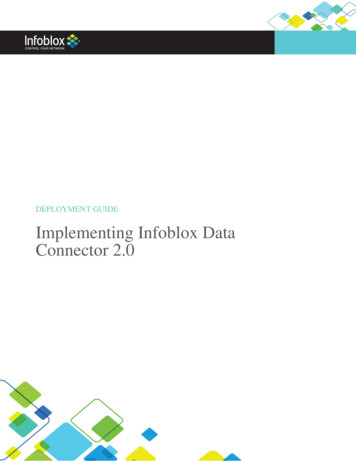
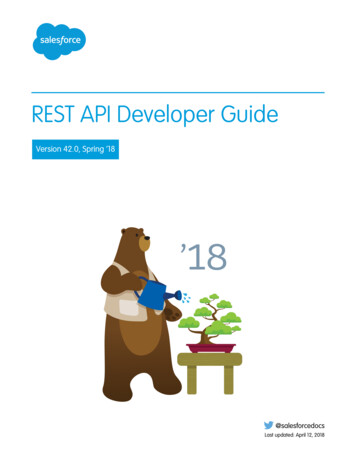
![API Ballot: [Ballot ID] – API 510 & API 570, Deferrals, Rev05](/img/5/api510andapi570deferralsrev5.jpg)
